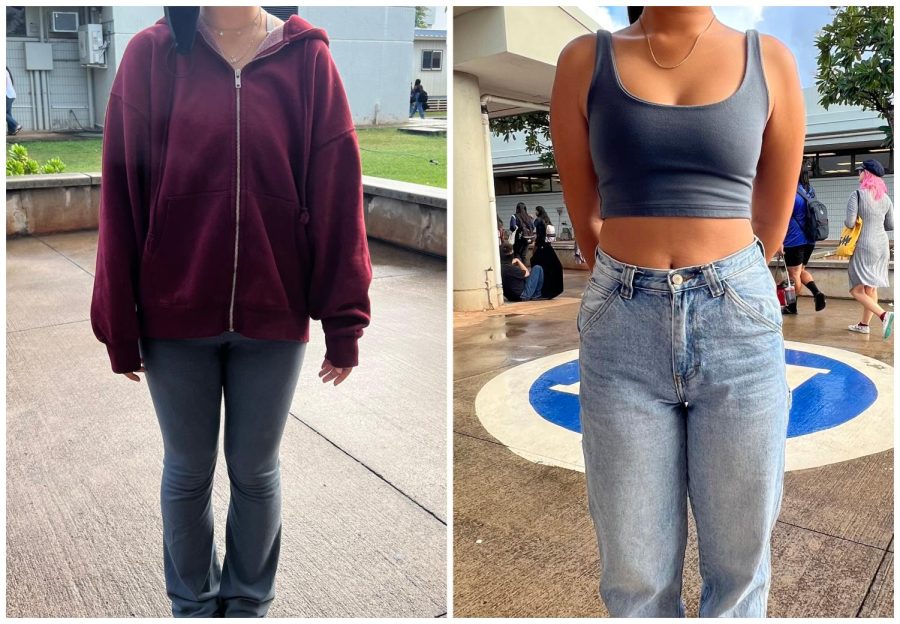Is your fashion passin’?
November 18, 2022
Moanalua High School is given the privilege to dress freely. Our clothing is another way to individualize and express who we are but, for the safety of our students, there are guidelines that we have to follow. Outfits with visible underwear, exposed midriff and bottoms, low hanging pants, clothes with suggestive pictures, offensive phrases, and displaying/advertising drugs, alcohol, or weapons will be cited as cress code violations.
Junior Ariyanna Padello thinks that most of the dress guidelines make sense. However, she said Moanalua High School’s guidelines target females more often.
“It’s weird how far us girls have to cover up,” Padello said. “If [the administration put its] focus on us rather than everybody, it really feels like they’re targeting us.”
Padello stated that she got dress-coded two times this school year. One of the incidents involved her wearing an acceptable-length shirt that rolled up when she reached down to get something on the ground. As a result, a teacher sent her to the office because she accidentally showed a bit of skin. Padello declared that she wore this shirt multiple times to school, but she didn’t get dress-coded until that time.
Rumblings among students about the imbalance in the dress code and its enforcement began at the orientation assemblies during the first week of the school year. At the assemblies, students watched a video about our school’s dress guidelines, and many found that the entire video focused on only girls’ attire.
“I think it was a bit misogynistic, especially because I used to see guys with their pants hanging or with their shirts off and they wouldn’t get dress-coded,” senior Hayley Nuesca said. “All of the people that I see get dress-coded are girls.”
Teachers at Moanalua High School have the ability to refer someone to the office if they violate the dress-guidelines. AP Language and Composition teacher Kymberli McKay and World History teacher Brandon Santos both said they have not sent anyone to the office regarding students violating the dress guidelines.
“I do think that it’s important to have standards in school regarding any dress code,” Mckay said. “But I feel like a lot of standards [of Moanalua’s code] pertain specifically toward girls”.
In one class, McKay said she saw a girl wearing a tube top. Instead of referring her to the office, she simply told her to put a jacket over it.
Mr. Santos, on the other hand, thinks otherwise.
“I think the [dress guidelines] are fair, but how it’s structured, I would like to have more students have more input into it, because they’re the ones wearing the clothes,” Santos said. “It’s kind of hard for them to follow the rules if they don’t have an input on it.”
Although the dress guidelines apply to male, female, and anyone in between, most guys don’t usually have any issues when following the dress-guidelines. When it comes to girls’ attire, it’s more restrictive than the rules set on boys’ attire. Some of this might be because girls simply have more clothing style options than boys.
Junior Oscar Ma said that everyone should be able to wear whatever they want to further express themselves. However, he’s stated that to an extent, there should be some limits to what is considered unacceptable. Ultimately, Ma said that the school’s guidelines are favored towards boys, and targeted against girls.
Moanalua High School Vice Principal Tara Hathaway said the number of students who get cited for dress code violations varies day by day. On some days, no students would get sent to the office, and other days, the number would go up to double digits. When students violate the dress guidelines, the VP’s will remind the student about the dress-guidelines and what is required. To resolve the problem, they’re given a different shirt to wear for the rest of the day. The shirts are donated by faculty and staff. Once the day ends, students pick up the violated clothing item at the VP’s office.
“I think it’s important to know that we have the dress guidelines to help encourage students to dress appropriately for formal education,” Hathaway said. “In each situation, you dress differently; you dress differently going to the beach, as you do going to the mall, as you do going to school. We just want [students] to dress accordingly for where they’re at.”
Hathaway said part of the school’s responsibility is to prepare students for the real world, and knowing how to dress for different situations is part of that.
“[Appropriate dress] is something that needs to be taught and encouraged,” Hathaway explained. “We are helping them for their future to dress appropriately for each setting.”
Most schools in the US follow the same set of rules regarding the dress-guidelines: No exposed underwear, no exposed midriffs, exposed bottoms, no clothing with suggestive pictures or offensive phrases. Kohala High School on the Big Island gave the students an easy way to remember how to dress: “If you are covered between your armpits and the bottom of your buttocks and everywhere in between, you’re good.”
Castle High School in Kaneohe recently made the news about its student-designed dress code. Students work with their administration to design dress-guidelines the student body can live with. Its Model Dress Code declares “All students to dress comfortably for school without the fear of or actual unnecessary discipline or body shaming. Also, they believe that students and faculty and staff should understand that they are responsible for managing their own personal “distractions” without regulating individual students’ clothing/self expression”.
The Model Dress Code states that only certain body parts must be covered for all students of Castle High. According to their dress-code requirements, clothes must be worn in a way such that genitals, buttocks, and nipples are covered with opaque material, and that cleavage should not have coverage requirements. However, clothing with violent images or language, profanity, hate speech, and/or pornography are still restricted.
Junior Mikaylah Mendez said she somewhat agrees with Castle High School’s new Model Dress Code.
“I agree with Castle [High School’s] new dress-code. It’s less restricting and fair for both male and females,” Mendez said. “I think Moanalua [High School] should enforce a similar dress-code because since the dress-code is more targeted towards girls, uplifting the restrictions against them will be fair for everyone. Plus, girls should decide what they want to wear and what they’re comfortable with wearing.”
Moanalua High School’s Peer Education Program had many discussions about the dress guidelines last year. Principal Robin Martin tasked the group last school year to determine if any changes were necessary to the dress code.
The PEP students agreed that the dress guidelines are too subjective and sexist. In addition, because of the inconsistencies of some teachers not enforcing the dress guidelines, students said that if one person enforces the dress-code, everyone should enforce it. If it’s not equal, then it’s not fair. PEP Club President, Avery Funasaki, said that the dress guidelines is black-and-white, meaning the rules against boy’s and girl’s attire are too different.
“I think the dress-code is fair, but the way that it’s executed is unfair,” PEP Club Vice President, Ashlee Sakamoto said. “The way that the administration uses it is unfair.”
In the end, however, the students found it difficult to find solutions that everyone, including the administration, would be satisfied with. The best solution that they came up with is a finger measuring system, which allows students to check if the amount of skin they’re showing is acceptable. If the length of your shirt is or longer than 2-3 fingers wide from the waist band, it would be okay to wear it to school. However, this idea would only be relevant if the administration permits showing midriff.
Unless there is a concerted effort to change Moanalua’s dress code, students are expected to dress appropriately for a formal learning environment. Those who violate the dress-code will be sent to the office, and the administrators will contact parents to bring appropriate attire.
For more information about Castle High School’s Model Dress Code, please visit https://www.castlehs.k12.hi.us/dress-code-policy.


